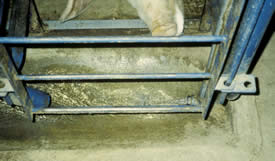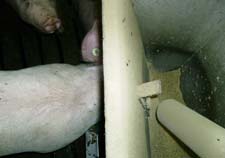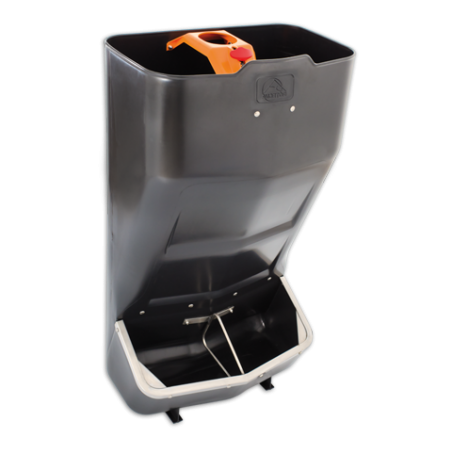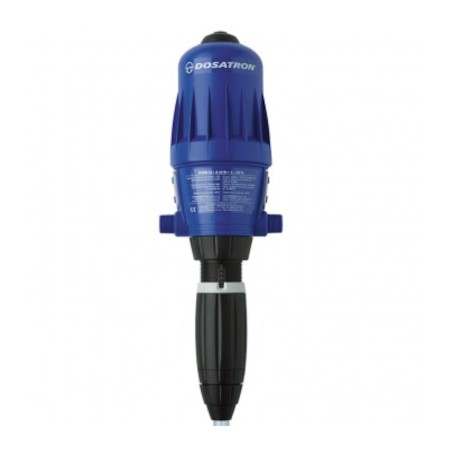The main objective we must consider is the "Risk / Benefit" and "Cost / Benefit" balance of administering collective oral medications. The greatest difficulty is generated when working with populations of pigs. During an outbreak, these medications are useful not only for treating sick animals, but also to reduce the impact of illness on healthy pigs in the group at risk for infection. The control does not equal "growth promotion" or a limitation or contraindication of the treatment groups for the simple reason that all animals of a population do not get not sick at the same time. But the economic objective (Figure 1) is not the only decision to make when deciding on a medication program; we must also consider the health and welfare of animals, as measured by morbidity and mortality (Figure 2) and the amount of antibiotics used (Figure 3). In short, we need to measure the actual "Risk / Cost / Benefit" of the disease in its entirety.
Figure 1. Economic objective.

Cost (US$) comparing 4 medication options
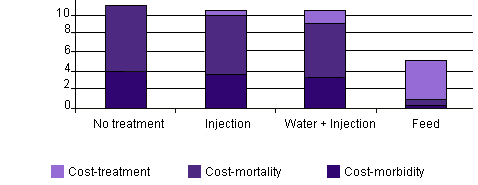
Figure 2. Morbidity and mortality.
Morbidity/Mortality comparing 4 medication options
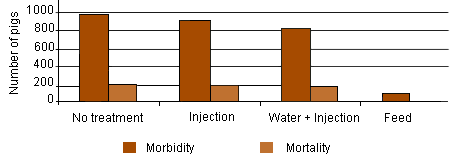
Figure 3. Amount of antibiotic used.
Length of treatment (days/pig) comparing 4 medication options

Source: Morrison, R. and Deen, J. 2003. Proc. Leman Swine Conference (243-247).
Oral medication: water or feed?
Major oral medications used in water and feed:
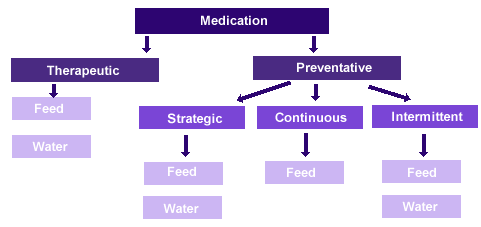
Type of oral medications based on the productive stage:

| Medication route | Productive phase |
*AERG (%) 20 farms with 456 sows/farm
|
||
|
Illness treatment
|
Illness prevention
|
Growth Promoters
|
||
| Feed | Farrowing |
18,5%
|
81,5%
|
0,0%
|
| Nursery |
12,9%
|
79,9%
|
7,2%
|
|
| Fattening |
10,8%
|
47,1%
|
42,1%
|
|
| Sows |
93,0%
|
7,0%
|
0,0%
|
|
| Water | Nursery |
13,6%
|
86,4%
|
-
|
| Fattening |
100,0%
|
0,0%
|
-
|
|
| Sows |
100,0%
|
0,0%
|
-
|
|
| Rosengren et al., 2004 *AERG: Antimicrobial Exposure Rate x 1000 "pig-days" |
||||
Both "vehicles" for oral medication may be valid and often complementary, but as when making any decision we must consider several factors along with their advantages and disadvantages:
|
Water medication
|
|
|
Advantages
|
Disadvantages
|
| • EASE of administration. • SPEED of establishing the medication • VERSATILITY to make immediate changes to medication. • CONTROL to monitor occasional consumption and make changes. • STRATEGY since water is more viable in the case of inappetence. • EFFECTIVENESS in preventive and therapeutic medications. • LOWER COST once the medication of specific groups has been established. |
• HIGHER INITIAL INVESTMENT in facilities with different lines to medicate groups.
|
|
Feed medication
|
|
|
Advantages
|
Disadvantages
|
|
• Management COMFORT.
|
• SLOW response from when ordering until you feed the pigs. • CONTROL: it is difficult to know the daily consumption with exactitude. • LOW FLEXIBILITY: difficulty in administering low-dose variations as needed. • COMPLIMENTARY FACILITIES needed to medicate, such as silos and storage areas. • UNDERMEDICATION: as sick pigs tend to eat less feed. • HIGHER COSTS of feed prices and reduced margins. • SAFETY since there is high risk of waste. |
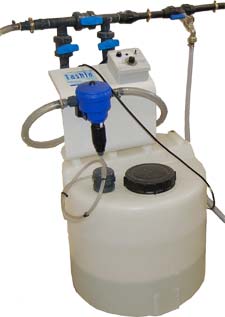 The starting point is to have facilities in perfect condition and choose the appropriate medication with equal conditions. Animals must receive the proper dosage, avoiding cross contamination.
The starting point is to have facilities in perfect condition and choose the appropriate medication with equal conditions. Animals must receive the proper dosage, avoiding cross contamination.
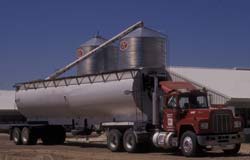
In order to make the choice of medicating feed or water, we should analyze each situation:
- What is the nature of the process?
- What do we do? Prevent, cure, eradicate ...
- What products are available? Water and / or feed ...
- What treatment strategy are we going to follow? Dose, duration ...
- How much will it cost?
- What are the potential losses?
- Safety? Waste, resistance ...
- Are the facilities available? Liquid feed, double silo, wet / dry hopper, pacifiers, cups ...
- Is the management correct?
- Should we ...?
The "economic" choice is clear when comparing two antibacterial products that can be used in both ways:
|
Comparison of oral medication in feed (F) vs. water (W)
|
|||||
|
Active product
|
Medication cost/day
|
||||
|
Little loss of water
|
High loss of water
|
Combined: 3 d. water + 7 d. feed
|
5 d. water vs. 10 d. feed
|
Lowered feed intake
|
|
| Tiamulin | W=F x 6 | W=F x 7,2 | W+F=F x 2,5 | W=F x 3 | W=F x 4 |
| Doxycycline | W=F x 3 | W=F x 3,6 | W+F=F x 1,5 | W=F x 1,5 | W=F x 2 |
For example, if animals have a lowered feed intake (fever ...) we increase the dose by 25-30% and if they have a nipple type drinker or water losses, we increase the dose by 20-50%. Normally in acute diseases, the initial route of choice is water with parenteral support since high levels of active compound in the blood will be reached quickly. In case of chronic diseases or preventive treatments, these are treated with feed, controlling its evolution.
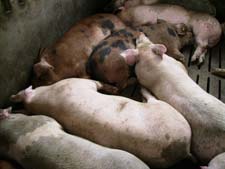 |
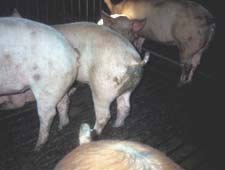 |
| Pigs with lowered feed intake. Respiratory process due to Actinobacillus pleuropneumoniae (left) and enteric disease due to Brachyspira hyodysenteriae (right). | |
We must take into account the influence of disease on medicated feed and water consumption. A study (Pijpers et al., 1991) investigated the use of medicated feed and water in pigs with A. pleuropneumoniae.
Consumption of water and food before and after becoming ill (↓) with A. pleuropneumoniae (— ) and control (- -). Consumption was measured twice daily (8:00 h and 17:00 h).
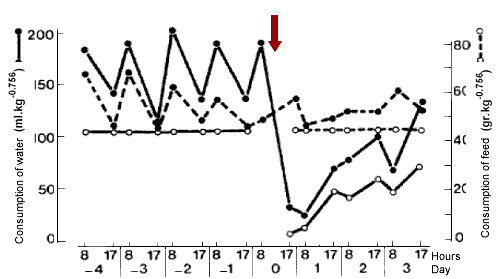
Pijpers et al. 1991 (J.Anim Sci 1991.69:2947-2954)
Although feed consumption is further reduced, both are reduced after becoming ill and recovered gradually during the process. In this case the best way to treat or parenteral would increase the amount of oral antibacterial.
Studies have also been carried out (Gottlob et al., 2007) to see the response to oral medication by comparing feed and water:
Effect of medicating water and feed on growth
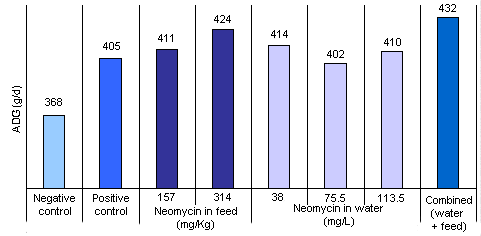
Effect of medicating water and feed on cost (water + medication per kg of meat gained)
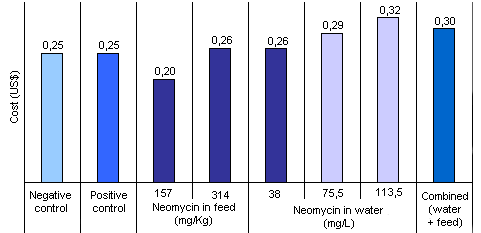
Negative control: Unmedicated.
Positive control: Unmedicated water and feed with Neomycin (154 mg / kg) and OTC (154 mg / kg).
‘Combined’ group: Water with Neomycin (75.5 mg / L) and feed with neomycin (154 mg / kg) + OTC (154 mg / kg).
Source: Gottlob, et al., 2007.
…and comparing continuous and intermittent medication in water and feed:
Effect of intermittent water medication on growth
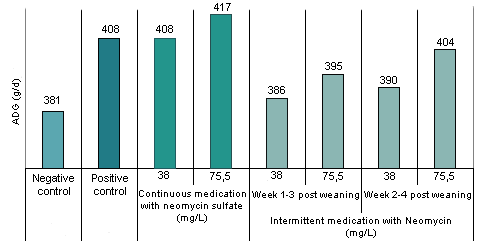
Effect of intermittent water medication on cost
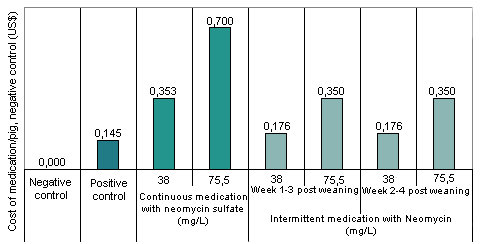
Negative control: Unmedicated
Positive control: Unmedicated water and feed with Neomycin (140 mg / kg) and OTC (140 mg / kg).
Source: Gottlob, et al., 2005.
"The goal is to minimize the time between disease onset and initiation of treatment for a good result."
T. Wolff (2005) found that 65% of animals died from respiratory problems and at least 50% of dead pigs had not been identified as sick animals and were untreated. After this, he made a study comparing preventive medication in feed vs. therapeutic medication in water with the following results:
Therapeutic water medication vs. Preventitive feed medication
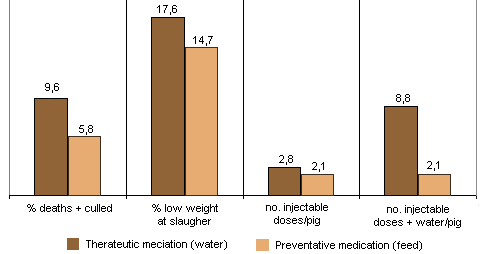
Therapeutic water medication vs. Preventitive feed medication (Cost US$)
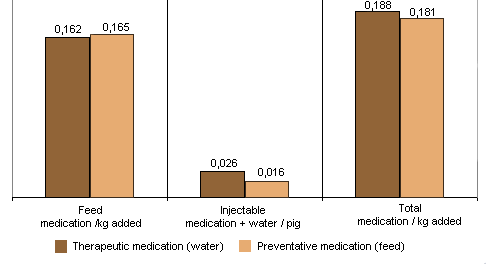
Source: Wolff, T. 2005



